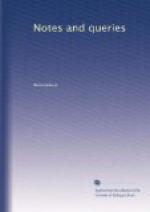I need not remind your readers that the maritime code of Wisby even now influences many of the most important decisions affecting our present mercantile shipping, it having been the model of the Laws of the Acquitanian Islands of Re and Oleron, which Richard I. ordered to be observed in England, and which are still frequently acted on. It is, however, to the notice which I have marked in Italics that I would call the attention of V.,—the destruction of the city on account of a small pane of glass not the value of an obolus: and as he, no doubt, has interested himself on these northern histories, request him to explain the circumstance more in detail. I myself have often determined on searching Pontanus, and other ancient Danish authorities, but hitherto neglected, and therefore know nothing about the matter.
As to the gates, which are more especially mentioned amongst the spoils of the ruined Wineta, we find them also noticed in the same work, at its account of Wineta:
“Urbem frequentabant Graeci aut potius Russi multarumque aliarum nationum mercatores, quorum affluxus frequens civibus ingentes divitias et facultates conciliavit: adeo ut portae civitatis ex aere paratae, et argentum tam vulgare ibi esset ut ad communium et vilium rerum usum adhibetur.”
To go, however, completely into the history of these gates would require a volume. It would be necessary to commence with the great veneration for gates in general throughout the north: whether the name of their great god Thor (a gateway) is cause or consequence would have to be considered, and his coincidence, in this respect, with Janus and Janua, the eldest deity of the Italians, which I have more largely discussed in an Essay on a British Coin with the Head of Janus, in the 21st No. of the Journal of the British Archaeological Association. Next, the question would arise, whether these gates have not been migratory, like those of Somnauth, which Mahmoud took to Gazni from a similar principle of deeply-rooted ancient veneration,—relics of sanctity rather than trophies of victory, and which Lord Ellenborough was so unjustly ridiculed for endeavouring to restore. Thirdly, therefore, also whether the famous gates of the cathedral of Novogorod may not be identical with those which have successively adorned Vineta’s and Wisby’s portals; and whether those which are still the ornament of the west door of the cathedral of Hildesheim, (which, according to the inscription which crosses their twenty scriptural bas-reliefs, were cast by Bereward, the thirteenth bishop, in 1015), may not be an existing and beautiful example; as is the bronze column, with the bas-reliefs of passages of the New Testament winding round it, and placed in the same cathedral close. It would not be too much to surmise, that even the beautiful gate of the Florence baptistery are from the same atelier, as an old Italian author sings:




